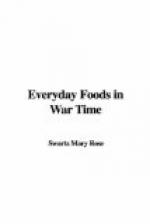Honey, “the distilled sweetness of the flower,” commands a price commensurate with the exquisiteness of its production, but is not quite as easy of digestion as some other forms of sugar. Because of its intense sweetness it may be combined with advantage with less sweet syrups, such as corn syrup. The cook estimates that by measure it will take one and a half times as much corn syrup as cane sugar to get the customary effects in sweet dishes. By using one part of honey to three of corn syrup a sweeter product is obtained, which is free from several of the disadvantages of honey in cookery.
Maple syrup and sugar are not only prized for their sweetness, due to the presence of ordinary cane sugar, but for the delicate “maple” flavor so difficult to duplicate. Nutritionally a tablespoon of maple sugar is equivalent in fuel value to about four-fifths of a tablespoon of cane sugar, while equal volumes of cane molasses, corn syrup, and maple syrup are interchangeable as fuel, though not of equal sweetening power.
Molasses is a less one-sided food than cane sugar or corn syrup. The latter furnish nothing but fuel, and if used too freely not only disturb digestion but tend to crowd out foods which yield mineral salts. Molasses is quite rich in calcium, one tablespoonful yielding as much as five ounces of milk, and is for this reason a better sweet for growing children than ordinary sugar or corn syrup when the amount of milk which they can have is limited, or when fruits and vegetables are hard to get. Molasses ginger snaps make, therefore, an excellent sweet for children, much better than candy, but of course to be eaten only at meal time.
The aim of good home cooking should be to please the family with what they ought to eat. The chef in a big hotel may have to prove the superiority of his art over that of a rival chef, and vie with him in novelty and elaboration, but the home cooking may be ever so simple provided the result is a happy, well-nourished family. A chocolate layer cake that takes two hours out of a day is no more nourishing than the same materials served as poached eggs, bread and butter, and a cup of chocolate. It is worth while to train a family to enjoy the flavor of simply prepared foods, and to realize that the food is the thing which counts and not the way it is dressed up. On the other hand, if one has to use a few food materials over and over, as one must in many places when the money that can be spent for food is very little, it is by slight changes in their form and flavor that one keeps them from palling on the appetite. If one has to use beans every day, it is a good thing to know a dozen different ways of preparing beans. One may have the plain bean flavor, properly toned up by a suitable amount of salt; the added flavor of onions, of tomatoes, of fat pork, of molasses, or a combination of two or three. One may have plain oatmeal for breakfast (the flavor developed by thorough cooking, at least three or four hours in a double boiler or over night in a fireless cooker); oatmeal flavored with apples in a pudding for dinner; or oatmeal flavored with onions and tomatoes in a soup for supper; the same food but quite different impressions on the palate.




